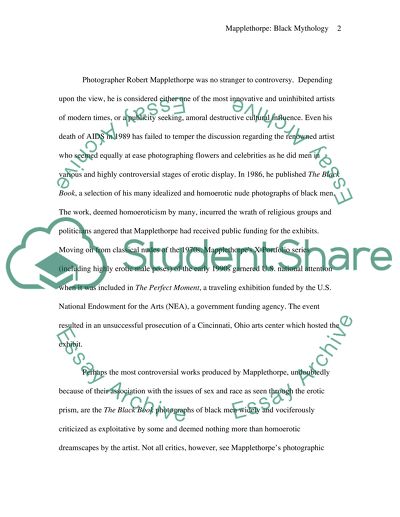Cite this document
(“What kinds of issues have been fore-grounded in the debates around the Essay”, n.d.)
Retrieved from https://studentshare.org/miscellaneous/1563225-what-kinds-of-issues-have-been-fore-grounded-in-the-debates-around-the-black-male-nudes-of-robert-mapplethorpe-did-mapplethorpe-reproduce-a-mythical-black-masculinity-or-invent-new-ways-of-seeing-what-kobena-mercer-calls-the-homoerotic-imaginary
Retrieved from https://studentshare.org/miscellaneous/1563225-what-kinds-of-issues-have-been-fore-grounded-in-the-debates-around-the-black-male-nudes-of-robert-mapplethorpe-did-mapplethorpe-reproduce-a-mythical-black-masculinity-or-invent-new-ways-of-seeing-what-kobena-mercer-calls-the-homoerotic-imaginary
(What Kinds of Issues Have Been Fore-Grounded in the Debates Around the Essay)
https://studentshare.org/miscellaneous/1563225-what-kinds-of-issues-have-been-fore-grounded-in-the-debates-around-the-black-male-nudes-of-robert-mapplethorpe-did-mapplethorpe-reproduce-a-mythical-black-masculinity-or-invent-new-ways-of-seeing-what-kobena-mercer-calls-the-homoerotic-imaginary.
https://studentshare.org/miscellaneous/1563225-what-kinds-of-issues-have-been-fore-grounded-in-the-debates-around-the-black-male-nudes-of-robert-mapplethorpe-did-mapplethorpe-reproduce-a-mythical-black-masculinity-or-invent-new-ways-of-seeing-what-kobena-mercer-calls-the-homoerotic-imaginary.
“What Kinds of Issues Have Been Fore-Grounded in the Debates Around the Essay”, n.d. https://studentshare.org/miscellaneous/1563225-what-kinds-of-issues-have-been-fore-grounded-in-the-debates-around-the-black-male-nudes-of-robert-mapplethorpe-did-mapplethorpe-reproduce-a-mythical-black-masculinity-or-invent-new-ways-of-seeing-what-kobena-mercer-calls-the-homoerotic-imaginary.


